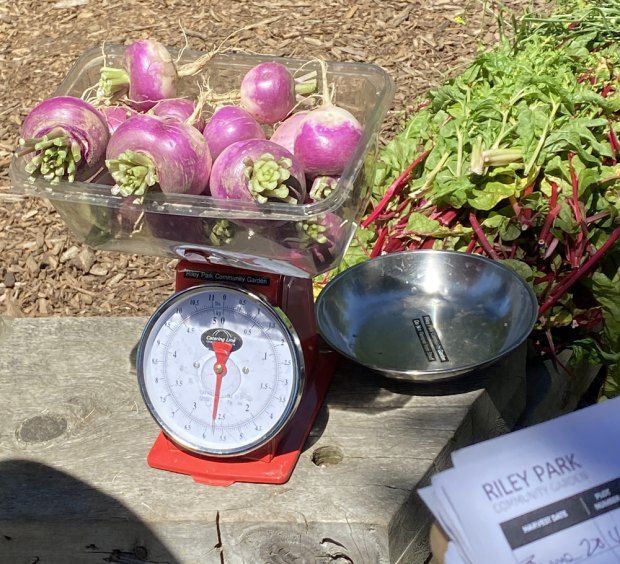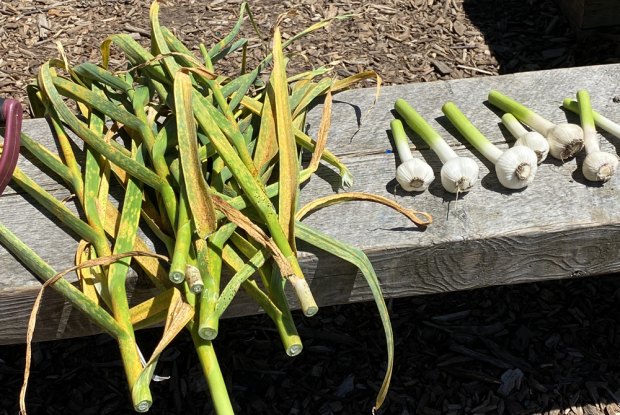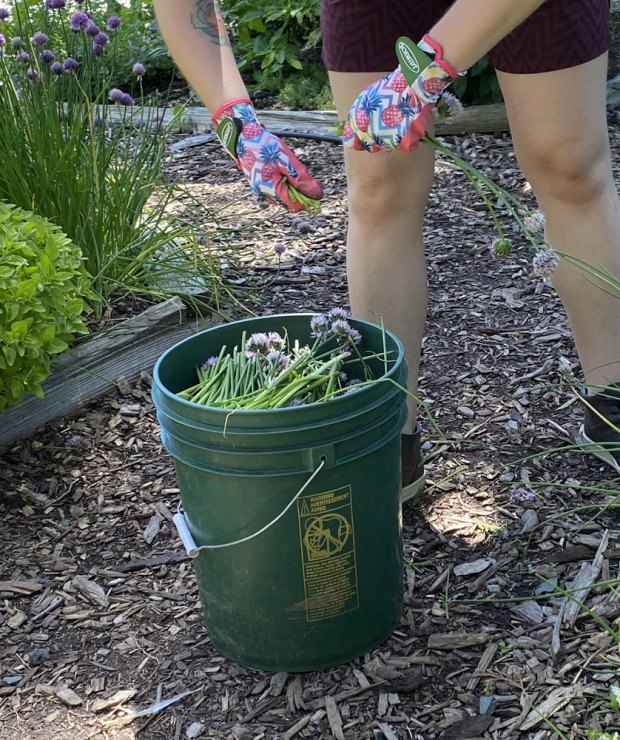
When Riley Park Community Centre was torn down in 2012, a team of community gardeners-cum-activists lobbied the Vancouver Board of Parks and Recreation for the space to be returned to the community. With the requisite complementary skillsets, such as soil science, horticulture, landscape architecture, and art, plus a range of valuable experiences, these people then came together to convert land that had been a swimming pool into a community garden. And this would not just be any community garden, but a pollinator garden. The team agreed to place a high priority on plant biodiversity with pollinator-friendly plants in bloom in all seasons.
And many of them would be native plants. As a result, bees, bumble bees, syrphid flies, and butterflies are frequent visitors to Riley Park Community Garden.
Converting the rubble and remains of a torn-down swimming pool into a garden in which plants can grow, actually flourish, is no mean feat. The community garden was designed and 200 cubic yards of sandy loam soil were brought in. Over the years, an irrigation system has been evolving so that now all of the planted areas in the garden, including the fourteen and a half raised beds for growing vegetables can be irrigated.
The raised beds provide 30 cm (12 ins) depth of soil for plants to root into. In addition, five accessible beds were built for those who can only garden at waist height and for teaching groups of children about growing food.
In most community gardens in Vancouver—there are over 110 of them—individuals can sign up for a plot of their own (or are wait-listed) to grow the flowers, fruits, and vegetables of their own choosing. Running it this way the first year, the Riley Park Community Garden team realized plot holders tended to be enthusiastic in the spring but to disappear by June, leaving untended crops to waste. The team decided not to use this management formula and instead run this as a communally managed pollinator garden along the successful style of a well-managed commons.[i]
I chatted with Art Bomke, PhD, who happened to drop by. He is a retired professor from the Faculty of Land and Food Systems at the University of British Columbia (UBC). He was on the original Riley Park Community Garden planning team, designing the raised bed system to offset the lack of soil and internal drainage on the site. He sourced a suitable soil needed for the range of planting options envisaged for this biodiverse garden, which even includes a vertical garden and espaliered fruit trees: apples, pears, and figs.
Riley Park garden is unique, having been the subject of several years of soil sampling by UBC students in Sustainable Soil Management, a similar program to the soil testing practiced at the UBC Farm, Centre for Sustainable Food Systems. Art also maintains connections with the UBC Farm, which provides UBC students and others with an opportunity for volunteering and learning tried and true systems for growing our food.[ii] This year the farm will be celebrating twenty years of operation since its founding.
But, let’s get back to Riley Park Community Garden. The two Vancouver Master Gardeners now running the garden are Selina Pope who has been there since the beginning and Angela Hoy
.Angela Hoy moved to Vancouver from a village in Oxfordshire, England, in 2017 to be near her daughter. She was already an accomplished gardener and a Master Composter, a much-needed qualification in Canada. She completed her training with the Vancouver Master Gardeners in 2020 and became a mentor to new Master Gardener students in 2021, when everything, including mentorship, moved online. In fact, as Angela was one of my mentors when I took Basic Master Gardener training this year, she is the one who introduced me to this pollinator space.
At Riley Park Community Garden, Angela is in charge of the three-bin compost system that provides the raised vegetable beds with much of the compost they require annually. She also consults on composting systems to other community gardens.
In addition to being a pollinator garden, Riley Park Community Garden is a demonstration and teaching garden. When I visited on June 20, Angela demonstrated to those attending the work party when and how to harvest broccoli.
I also heard her explaining to a volunteer the importance of protecting a cauliflower curd from the sun by bending its leaves over to prevent it from scorching so it can continue to develop into a harvestable-size head. She also demonstrated how to keep the garden less attractive to pests by removing yellowing leaves that are no longer nourishing a plant. Later, she was cutting the leafy tops off the broad beans above the highest bean so the plant would feed the beans rather than the foliage. She then prepared the foliage for the compost, cutting it as she dropped it in a bucket at her side.
Selina Pope, a member of the original design team at Riley Park, along with Art, has been gardening in some capacity since her twenties. In the new millennium, when she bought a house with a garden filled only with weeds, she trained in garden design at VanDusen Botanical Garden. She then qualified as a Master Gardener, all while working full time in Community Health. Naturally, she became active in the Healing Garden Committee of the Vancouver Master Gardeners.[iii] Each year that goes by, Selina becomes more of an expert. For the past fifteen years, she has devoted all her volunteer Master Gardener hours to her home community of Little Mountain neighbourhood and has developed a hub called the Little Mountain Garden Network.
A few steps away from the community garden, in another location of Riley Park, she is involved with several additional facilities: the Potting Studio, the green house (which was found, donated to the cause, and hand-delivered by six seniors), and the Kids’ Learning Garden. She delivers workshops on food literacy, food security, and ecological sustainability.
More recently, Selina trained as a Butterfly Ranger in the Butterflyway Ranger program run by the David Suzuki Foundation; she is now a trainer in the program. And so Riley Park Community Garden is also a registered butterflyway. There’s a searchable Indigenous Pollinator Plant Map for Vancouver online, so you can see if there’s a butterflyway near you and/or register your own.[iv]
Selina demonstrated how to harvest garlic while I was there.
The garlic heads have grown a good size. Meanwhile, allium rust has blown in from elsewhere and infected the plants—the leaves only at this stage. Fortunately, the garlic will be harvested this week, June 27, after its planned nine months of growth, which will stop the disease progressing further.[v] Selina cut the harvested garlic stems short and all the discarded leaves will be going into Vancouver’s garbage system so as to avoid spreading the rust to other members of the onion family.
After several hours of gardening in the hot sun, everyone came together at the garden’s gathering place in the welcome shade of the Atlas cedar to eat some snacks and some garden strawberries, and drink some cold herbal tea. Plants were shared: pollinator perennials and annuals, and veggie starts such as cucumber. Indeed, I came home with a borage plant, an old-fashioned self-seeding medicinal herb, the flowers of which pollinators find appealing and so do I.
Meanwhile, bees, bumblebees, and butterflies were collecting pollen and nectar all around us. Some common butterflies that frequent the garden include western tiger swallowtail and painted lady.[vi] After all, Riley Park Community Garden is a pollinator garden.
Selina plans to do a Master Gardener tour of the Riley Park Community Garden this summer, so stay tuned for that.
Go visit. Sign up for a work party
.[vii] Start this week—it’s Canada’s National Pollinator Week, June 21 to 27.[viii]Nina Shoroplova, Vancouver Master Gardener Student















